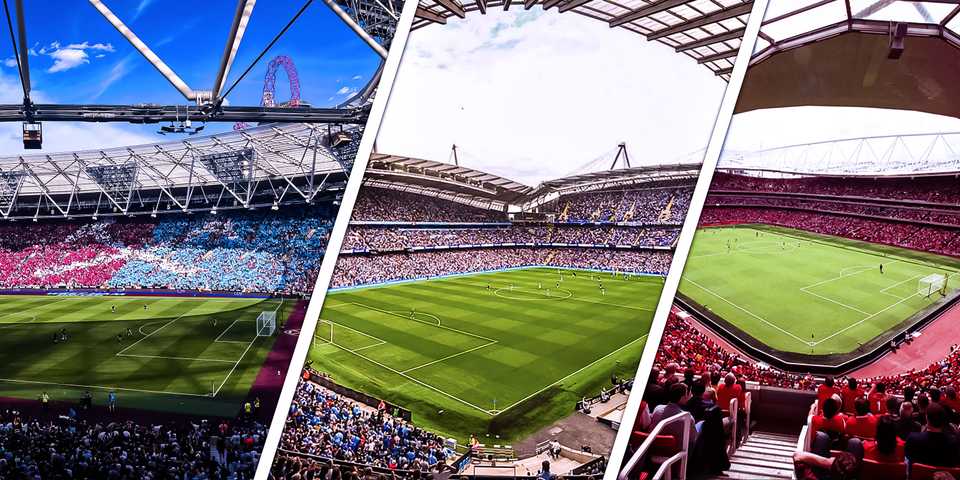
Premier League Stadium Attendance Levels for the 2024/25 Season
Football fans, often referred to as the “12th man,” play a crucial role in the sport, providing the energy and support that can influence a team’s performance. The passionate cheers and unwavering backing from the stands can often make the difference between victory and defeat.
Securing a ticket to a Premier League match can be a challenge, and those who attend regularly are both fortunate and integral to their clubs. With that in mind, which stadiums have been the fullest since the 2024/25 season began? Analyzing the capacity of all 20 top-flight grounds and the average number of attendees per match, here’s a breakdown of how full each stadium has been this season.
—
20-16: Fulham, Southampton, Chelsea, Wolverhampton Wanderers, Tottenham Hotspur
Leading off the list is Fulham, managed by Marco Silva. According to Transfermarkt, Craven Cottage has been filled to 89.7% of its capacity, with 26,550 fans attending on average out of a total 29,589 seats.
Next is Southampton, struggling at the bottom of the table. Their home, St. Mary’s Stadium, has the second-lowest occupancy rate at 96.0%, with 31,098 supporters filling the 32,284-seater venue.
Chelsea, under Enzo Maresca, initially saw a rise in attendance at Stamford Bridge, but as their performances dipped, so did the crowd numbers. The stadium is now 96.2% full on average, with 40,059 fans occupying 41,631 available seats.
Relegation-threatened Wolverhampton Wanderers, who recently appointed Vítor Pereira as manager, have also faced attendance struggles. Molineux has been 96.3% full this season, though the atmosphere is gradually improving.
Despite being home to one of the most modern stadiums in world football, Tottenham Hotspur have also found it difficult to fill their massive 62,850-seater stadium. Under Ange Postecoglou’s second season, their attendance rate sits at 97.5%, averaging 61,302 fans per home game.
—
15-11: Aston Villa, Leicester City, Manchester City, Manchester United, Liverpool
Aston Villa’s historic Villa Park is typically packed, though rising ticket prices have impacted attendance slightly. The stadium, which holds 42,918 fans, remains near capacity most weeks.
Leicester City, under Ruud van Nistelrooy, initially enjoyed strong support at the King Power Stadium, with a 98.6% attendance rate earlier in the season. However, this has since dropped to 97.8%, with some fans losing faith.
Manchester City often faces criticism for its home atmosphere, but the numbers tell a different story. The Etihad Stadium, which has 55,097 seats, is filled to 98.2% capacity on matchdays.
For Manchester United, the post-Sir Alex Ferguson era has been challenging, but Old Trafford still sees high attendance. With an average crowd of 73,820, the Theatre of Dreams remains a fortress for United supporters.
Liverpool, under Arne Slot, have continued to see strong backing at Anfield. An average of 60,472 fans—98.7% of capacity—attend matches, a number expected to rise if the Reds maintain their position at the top of the table.
—
10-6: Crystal Palace, Brighton & Hove Albion, Brentford, Nottingham Forest, Bournemouth
Crystal Palace saw a dip in matchday attendance early on due to fan frustrations with owner Steve Parish, but an upturn in form has led to a 98.8% fill rate at Selhurst Park.
Brighton & Hove Albion, under young manager Fabian Hürzeler, have continued their impressive home support. The Amex Stadium is nearly full every match, with 98.9% of seats occupied.
Brentford’s Gtech Community Stadium may be one of the smallest in the league, but it ranks 8th in attendance percentage, with a 99.0% occupancy rate.
Nottingham Forest, enjoying one of their strongest seasons in years, also boasts a 99.0% fill rate at the City Ground, as fans rally behind their team’s top-four ambitions.
Bournemouth’s Vitality Stadium, with a capacity of just 11,307, ranks 6th in attendance percentage. With a 99.0% full rate, the Cherries’ small stadium is consistently packed.
—
5-1: Ipswich Town, Arsenal, Everton, West Ham United, Newcastle United
Ipswich Town fans have embraced their return to the Premier League, supporting the team in their survival fight. 99.1% of 29,774 available seats at Portman Road are filled on matchdays.
Arsenal’s Emirates Stadium, one of the most modern venues in the league, maintains a 99.3% attendance rate, with fans consistently filling up the ground.
Everton are preparing to leave Goodison Park in the coming years, making every remaining game a special occasion. The historic stadium has a 99.3% occupancy rate as fans bid farewell.
West Ham United, despite inconsistent form, enjoy 99.8% attendance at the 62,500-seater London Stadium. The support remains strong following their 2022/23 Europa Conference League triumph.
At the top of the list, Newcastle United’s St James’ Park boasts a nearly sold-out crowd every match. With 52,189 fans attending on average out of 52,258 available seats, the Magpies continue to have one of the most passionate fanbases in the league.
Final Thoughts
Despite varying performances across the Premier League, matchday attendance remains strong for most clubs. While teams like Fulham and Southampton struggle to fill every seat, others—like Newcastle, Arsenal, and West Ham—continue to enjoy near-capacity crowds. As the season progresses, these numbers may shift depending on club performance and fan enthusiasm.
Leave a Reply